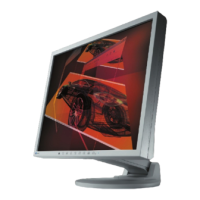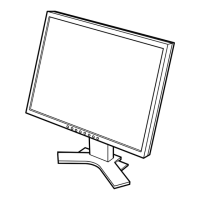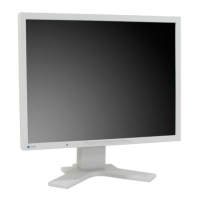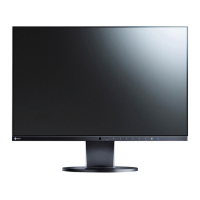24
Chapter 5 Troubleshooting
5-2. Imaging Problems (For Both Digital and Analog)
Problem Possible cause and remedy
1. The screen is too bright or too dark. • Use “Brightness” or “Contrast” in the Setting menu to
adjust it (see “Color Adjustment” (page 14)). (The LCD
monitor backlight has a limited life span. If the screen
becomes dark or begins to icker, contact your local EIZO
representative.)
• If the screen is too bright, try changing the Auto EcoView
setting to “On”. The monitor detects the ambient
brightness to adjust the screen brightness automatically
(see “Auto EcoView” (page 11)).
2. “Brightness” cannot be adjusted When Auto EcoView is set to “On”, “Brightness” may not be
adjustable due to the advanced settings of Auto EcoView.
• Cannot increase/decrease setting value (
or
is displayed in gray)
- “Brightness” adjustment menu via
operation switch
/
- “Brightness” adjustment menu in color
adjustment
/
• The bright adjustment range of the Auto EcoView function
can be limited to ensure that the screen is neither too
bright nor too dark. When the adjustment range is limited,
values outside the range cannot be set. If you want to
set a value outside the range, try changing the following
settings.
- Change the maximum and minimum values for
“Brightness” in the Auto EcoView advanced settings.
- Set Auto EcoView to “Off”.
For details on Auto EcoView settings, see “Auto EcoView”
(page 11).
• Cannot increase/decrease setting value (
and
are displayed in gray)
- “Brightness” adjustment menu via
operation switch
- “Brightness” adjustment menu in color
adjustment
• Brightness adjustment may not be possible when the
installation environment of the monitor is excessively
bright or dark. In this case, try changing the following
settings.
- Change the maximum and minimum values for “Ambient
Light” in the Auto EcoView advanced settings.
- Set Auto EcoView to “Off”.
For details on Auto EcoView settings, see “Auto EcoView”
(page 11).
3. Text is blurred
• Check whether the PC is congured to meet the resolution
and vertical scan frequency requirements of the monitor
(see “1-2. Supported Resolutions” (page 7)).
• When an image is displayed with a resolution other than
recommended, text or lines in the displayed image may
blur. In this case, try adjusting “Sharpness” in the Setting
menu (see “Sharpness” (page 17)).
4. Afterimages appear • Afterimages are particular to LCD monitors. Avoid
displaying the same image for a long time.
• Use the screen saver or power saving function to avoid
displaying the same image for extended periods of time.
5. Green / red / blue / white dots or dark dots
remain on the screen.
• This is due to LCD panel characteristics and not a
malfunction.
6. Interference patterns or pressure marks
remain on the screen.
• Leave the monitor with a white or black screen. The
symptom may disappear.
7. Noise appears on the screen. • When inputting HDCP system signals, normal images
may not be displayed immediately.
8. (When using DisplayPort signal input)
The positions of windows and icons are
shifted when the monitor is turned off/on
or when restored from power saving mode.
• Turn the setting “On” for “DP HPD Control” on the
“Administrator Settings” menu (see “DP HPD Control”
(page 22)).
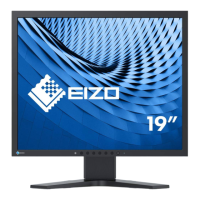
